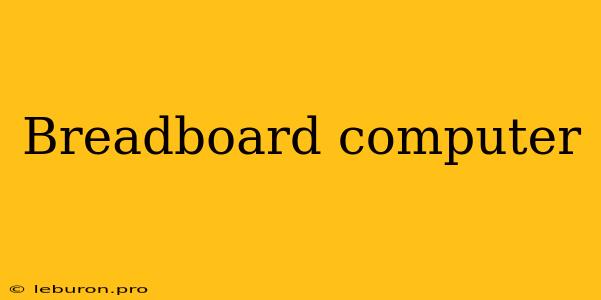The realm of computer engineering is constantly evolving, with new technologies and approaches emerging to redefine the way we interact with and utilize these powerful tools. One such innovation is the breadboard computer, a fascinating concept that allows for the construction of a functional computer using a breadboard, a versatile tool often employed in electronics prototyping. This approach offers a unique blend of hands-on learning, customization, and affordability, opening up exciting possibilities for hobbyists, students, and even seasoned engineers. Let's delve into the world of breadboard computers, exploring their intricacies, potential applications, and the compelling reasons why they continue to capture the imagination of electronics enthusiasts.
The Essence of Breadboard Computers
At its core, a breadboard computer is a system built using a breadboard as the primary platform. This seemingly simple foundation allows for the connection and arrangement of individual electronic components, such as microcontrollers, memory chips, and input/output peripherals, to create a complete and operational computer system. The beauty of this approach lies in its flexibility and adaptability, enabling users to experiment with different configurations, architectures, and functionalities.
Building Blocks of a Breadboard Computer
To construct a breadboard computer, several key components are essential:
- Microcontroller: The heart of the computer, the microcontroller serves as the central processing unit (CPU) that executes instructions and controls the overall system. Popular choices include the Arduino family of microcontrollers, renowned for their ease of use and widespread availability.
- Memory: Both RAM (Random Access Memory) and ROM (Read-Only Memory) are necessary for storing data and program instructions. RAM provides temporary storage for active programs and data, while ROM holds permanent instructions and data.
- Input/Output Peripherals: These devices enable communication between the computer and the outside world. Examples include LEDs, buttons, sensors, displays, and communication interfaces like Ethernet or Wi-Fi.
- Power Supply: A regulated power source is required to provide the necessary voltage and current to operate the components.
Advantages of Breadboard Computers
The breadboard computer approach offers a compelling set of advantages that attract both seasoned engineers and budding electronics enthusiasts:
- Hands-on Learning: Building a breadboard computer provides an unparalleled hands-on learning experience, fostering a deep understanding of computer architecture, hardware components, and the underlying principles of computer operation.
- Customization: Breadboards offer exceptional flexibility, allowing users to tailor the computer system to their specific needs and project requirements. This includes customizing the CPU, memory, peripherals, and even the overall architecture.
- Affordability: The use of common, readily available electronic components makes breadboard computer construction significantly more affordable than purchasing pre-built systems. This accessibility opens up opportunities for experimentation and learning without significant financial investment.
- Prototyping: Breadboards serve as ideal platforms for prototyping computer systems. Engineers can rapidly iterate on designs, test new ideas, and refine their creations before committing to more expensive and permanent solutions.
Potential Applications of Breadboard Computers
Breadboard computers can be applied to a diverse range of projects, from educational endeavors to practical applications:
- Educational Tool: The breadboard computer is an invaluable teaching tool, enabling students to gain a comprehensive understanding of computer fundamentals through hands-on experimentation and exploration.
- Robotics: The flexibility of breadboard computers makes them well-suited for controlling robotic systems, allowing developers to customize the control algorithms and integrate a variety of sensors and actuators.
- Internet of Things (IoT): Breadboard computers can serve as the brains for IoT devices, connecting sensors, actuators, and communication modules to create intelligent and interconnected systems.
- Custom Embedded Systems: The ability to tailor breadboard computers to specific requirements makes them ideal for developing custom embedded systems for various applications, such as home automation, industrial control, and data acquisition.
Conclusion
The breadboard computer represents a unique and powerful approach to computer design and construction, offering a blend of hands-on learning, flexibility, affordability, and a wealth of potential applications. Whether you're a seasoned engineer seeking a prototyping platform or a budding electronics enthusiast eager to explore the inner workings of computers, the breadboard computer presents a compelling and rewarding avenue to embark on your journey into the world of computer engineering.
